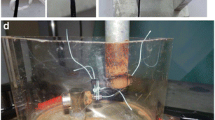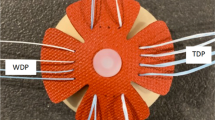Abstract
Purpose
The purpose of this study was to biomechanically evaluate suture–tendon interface and tissue holding of three sutures in torn and degenerated versus intact human rotator cuffs.
Methods
Sixty-three human rotator cuff tendons were divided into torn degenerated group (TDG), n = 21 and intact group (IG), n = 42. Ultimate tension load (UTL) and cyclic loading were tested for three arthroscopic sutures: simple, horizontal, and massive cuff sutures (MCS).
Results
Ultimate tension load was significantly higher (p < 0.05) for the MCS (194 ± 68 N) in comparison with the simple (105 ± 48 N) and horizontal sutures (141 ± 49 N) in IG. In TDG, UTL was not significantly higher (n.s.) for MCS (118 ± 49 N), simple (79 ± 30 N), and horizontal sutures (107 ± 28 N) in comparison with IG. MCS (118 ± 49 N) showed no significantly superior UTL in comparison with the simple and horizontal sutures in the TDG. MCA elongation was 0.6 ± 0.7 mm in the IG and 1.3 ± 0.7 mm in the TDG, while horizontal suture elongation was 0.7 ± 0.4 mm in the IG and 1.3 ± 0.5 mm in the TDG. Simple suture elongation was 1.1 ± 0.5 mm in the IG and 1.6 ± 0.7 mm in the TDG.
Conclusion
Human torn and degenerated rotator cuffs have poor tissue quality, significantly lower UTL and higher cyclic elongation in comparison with intact cuffs regardless of the type of suture used for repair, which invites the need for repair techniques that grasps greater tissue volume in addition to augmentation techniques.
Clinical relevance
Clinicians better use repair techniques that grasp greater tissue volume (e.g. MCS, modified Mason–Allen cross bridge, double-row cross bridge, etc.) when repairing the torn and degenerated rotator cuffs.




Similar content being viewed by others
References
Accousti KJ, Flatow EL (2007) Technical pearls on how to maximize healing of the rotator cuff. Instr Course Lect 56:1–10
Barber FA, Coons DA, Ruiz-Suarez M (2007) Cyclic load testing of biodegradable suture anchors containing 2 high-strength sutures. Arthroscopy 23:355–360
Bardana DD, Burks RT, West JR, Greis PE (2003) The effect of suture anchor design and orientation on suture abrasion: an in vitro study. Arthroscopy 19:274–281
Bynum CK, Lee S, Mahar A, Tasto J, Pedowitz R (2005) Failure mode of suture anchors as a function of insertion depth. Am J Sports Med 33:1030–1034
Chahal J, Van Thiel GS, Mall N, Heard W, Bach BR, Cole BJ, Nicholson GP, Verma NN, Whelan DB, Romeo AA (2012) The role of platelet-rich plasma in arthroscopic rotator cuff repair: a systematic review with quantitative synthesis. Arthroscopy 28(11):1718–1727
Cho NS, Lee BG, Rhee YG (2011) Arthroscopic rotator cuff repair using a suture bridge technique: is the repair integrity actually maintained? Am J Sports Med 39(10):2108–2116
Cole BJ, ElAttrache NS, Anbari A (2007) Arthroscopic rotator cuff repairs: an anatomic and biomechanical rationale for different suture-anchor repair configurations. Arthroscopy 23:662–669
Cole AS, Cordiner-Lawrie S, Carr AJ, Athanasou NA (2001) Localised deposition of amyloid in tears of the rotator cuff. J Bone Joint Surg Br 83(4):561–564
Cummins CA, Murrell GA (2003) Mode of failure for rotator cuff repair with suture anchors identified at revision surgery. J Shoulder Elbow Surg 12:128–133
DeHaan A, Axelrad T, Kaye E, Silvestri L, Puskas B, Foster T (2012) Does double-row rotator cuff repair improve functional outcome of patients compared with single-row technique? : a systematic review. Am J Sports Med 40:1176–1185
Meyer DC, Wieser K, Farshad M, Gerber C (2012) Retraction of supraspinatus muscle and tendon as predictors of success of rotator cuff repair. Am J Sports Med 40:2242–2247
Gartsman GM, Khan M, Hammerman SM (1998) Arthroscopic repair of full thickness tears of the rotator cuff. J Bone Joint Surg Am 80:832–840
Gerber C, Schneeberger AG, Perren SM, Nyffeler RW (1999) Experimental rotator cuff repair. A preliminary study. J Bone Joint Surg Am 81:1281–1290
Gerber C, Schneeberger AG, Beck M, Schlegel U (1994) Mechanical strength of repairs of the rotator cuff. J Bone Joint Surg Br 76:371–380
Gladstone J, Bishop J, Lo I, Flatow E (2007) Fatty infiltration and atrophy of the rotator cuff do not improve after rotator cuff repair and correlate with poor functional outcome. Am J Sports Med 35:719–728
Goutailler D, Postel JM, Gleyze P, Leguilloux P, Van Driessche S (2003) Influence of cuff muscle fatty degeneration on anatomic and functional outcomes after simple suture full-thickness tears. J Shoulder Elbow Surg 12:550–554
Habermeyer P, Magosch P, Lichtenberg S (2006) Classification of complete rotator cuff tears according to Bateman. Classifications of rotator cuff. In: Classifications and Scores of the Shoulder, 1st edn. Springer, Berlin-Heidelberg, p 23
Ide J, Maeda S, Takagi K (2005) A comparison of arthroscopic and open rotator cuff repair. Arthroscopy 21(9):1090–1098
Jones CK, Savoie FH III (2003) Arthroscopic repair of large and massive rotator cuff tears. Arthroscopy 19:564–571
Jo CH, Kim JE, Yoon KS, Lee JH, Kang SB, Lee JH, Han HS, Rhee SH, Shin S (2011) Does platelet-rich plasma accelerate recovery after rotator cuff repair? A prospective cohort study. Am J Sports Med 39(10):2082–2090
Oh JH, Kim SH, Kang JY, Oh CH, Gong HS (2010) Effect of age on functional and structural outcome after rotator cuff repair. Am J Sports Med 38:672–678
Kim DH, Elattrache NS, Tibone JE et al (2006) Biomechanical comparison of a single-row versus double-row suture anchor technique for rotator cuff repair. Am J Sports Med 34:407–414
Lafosse L, Brozska R, Toussaint B, Gobezie R (2007) The outcome and structural integrity of arthroscopic rotator cuff repair with use of the double-row suture anchor technique. J Bone Joint Surg Am 89(7):1533–1541
Lehmann C, Cuomo F, Kummer FJ, Zuckermann JD (1995) The incidence of full thickness rotator cuff tears in a large cadaveric population. Bull Hosp Jt Dis 54(1):30–31
Lee BG, Cho NS, Rhee YG (2012) Modified Mason–Allen suture bridge technique: a new suture bridge technique with improved tissue holding by the modified Mason–Allen stitch. Clin Orthop Surg 4(3):242–245
Lichtenberg S, Liem D, Magosch P, Habermeyer P (2006) Influence of tendon healing after arthroscopic rotator cuff repair on clinical outcome using single-row Mason–Allen suture technique: a prospective, MRI controlled study. Knee Surg Sports Traumatol Arthrosc 14(11):1200–1206
Lorbach O, Pape D, Raber F, Busch LC, Kohn D, Kieb M (2012) Influence of the initial rupture size and tendon subregion on three-dimensional biomechanical properties of single-row and double-row rotator cuff reconstructions. Knee Surg Sports Traumatol Arthrosc 20(11):2139–2147
Lorbach O, Kieb M, Raber F, Busch LC, Kohn DM, Pape D (2013) Three-dimensional evaluation of cyclic displacement in single-row and double-row rotator cuff reconstructions under static external rotation. Am J Sports Med 41(1):153–162
Ma CB, Comerford L, Wilson J, Puttlitz CM (2006) Biomechanical evaluation of arthroscopic rotator cuff repairs: double-row compared with single-row fixation. J Bone Joint Surg Am 88:403–410
Ma CB, MacGillivray JD, Clabeaux J, Lee S, Otis JC (2004) Biomechanical evaluation of arthroscopic rotator cuff stitches. J Bone Joint Surg Am 86-A(6):1211–1216
Mahar A, Allred DW, Wedemeyer M, Abbi G, Pedowitz R (2006) A biomechanical and radiographic analysis of standard and intracortical suture anchors for arthroscopic rotator cuff repair. Arthroscopy 22:130–135
Mattews TJ, Hand GD, Rees JL, Athanasou NA, Carr AJ (2006) Pathology of the torn rotator cuff tendon. Reduction in potential for repair as tear size increases. J Bone Joint Surg Br 88(4):489–495
Murray TF Jr, Lajtai G, Mileski RM, Snyder SJ (2002) Arthroscopic repair of medium to large full-thickness rotator cuff tears: outcome at 2- to 6-year follow-up. J Shoulder Elbow Surg 11:19–24
Nho SJ, Yadav H, Shindle MK, Macgillivray JD (2008) Rotator cuff degeneration: etiology and pathogenesis. Am J Sports Med 36(5):987–993
Ozbaydar M, Chung S, Diller D, Warner JJ (2007) Arthroscopic reconstruction of the rotator cuff: the current gold standard? Der Orthopäde 36(9):825–833
Park MC, Peterson A,Patton J, McGarry MH, Park CJ, Lee TQ (2013) Biomechanical effects of a 2 suture-pass medial inter-implant mattress on transosseous-equivalent rotator cuff repair and considerations for a “technical efficiency ratio” J Shoulder Elbow Surg. doi:10.1016/j.jse.2013.06.019
Rhee YG, Cho NS, Parke CS (2012) Arthroscopic rotator cuff repair using modified Mason–Allen medial row stitch: knotless versus knot-tying suture bridge technique. Am J Sports Med 40(11):2440–2447
Chung SW, Oh JH, Gong HS, Kim JY, Kim SH (2011) Factors affecting rotator cuff healing after arthroscopic repair: osteoporosis as one of the independent risk factors. Am J Sports Med 39:2099–2107
Sileo MJ, Ruotolo CR, Nelson CO, Serra-Hsu F, Panchal AP (2007) A biomechanical comparison of the modified Mason–Allen stitch and massive cuff stitch in vitro. Arthroscopy 23(3):235–240
Smith CD, Alexander S, Hill AM et al (2006) A biomechanical comparison of single and double-row fixation in arthroscopic rotator cuff repair. J Bone Joint Surg Am 88:2425–2431
Van Der Meijden OA, Wijdicks CA, Gaskill TR, Jansson KS, Millett PJ (2013) Biomechanical analysis of two-tendon posterosuperior rotator cuff tear repairs: extended linked repairs and augmented repairs. Arthroscopy 29(1):37–45
Weber SC, Kauffman JI, Parise C, Weber SJ, Katz SD (2013) Platelet-rich fibrin matrix in the management of arthroscopic repair of the rotator cuff: a prospective, randomized, double-blinded study. Am J Sports Med 41(2):263–270
Acknowledgments
The authors thank the Pathology Institute SMZ-South KH for support and help in obtaining the shoulder specimens, as well as Arthrex for donating the FiberWire® used in this study.
Author information
Authors and Affiliations
Corresponding author
Additional information
The current study was performed at Pathology Institute SMZ-South KH and at Orthopaedic Hospital Speising Vienna.
Rights and permissions
About this article
Cite this article
Wlk, M.V., Abdelkafy, A., Hexel, M. et al. Biomechanical evaluation of suture–tendon interface and tissue holding of three suture configurations in torn and degenerated versus intact human rotator cuffs. Knee Surg Sports Traumatol Arthrosc 23, 386–392 (2015). https://doi.org/10.1007/s00167-014-2988-3
Received:
Accepted:
Published:
Issue Date:
DOI: https://doi.org/10.1007/s00167-014-2988-3




